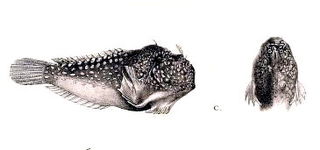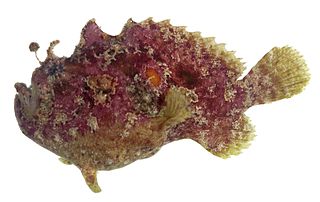
Frogfishes are any member of the anglerfish family Antennariidae, of the order Lophiiformes. Antennariids are known as anglerfish in Australia, where the term "frogfish" refers to members of the unrelated family Batrachoididae. Frogfishes are found in almost all tropical and subtropical oceans and seas around the world, the primary exception being the Mediterranean Sea.

The striated frogfish or hairy frogfish is a marine fish belonging to the family Antennariidae.

The epaulette shark is a species of longtailed carpet shark, family Hemiscylliidae, found in shallow, tropical waters off Australia and New Guinea. The common name of this shark comes from the very large, white-margined black spot behind each pectoral fin, which are reminiscent of military epaulettes. A small species usually under 1 m (3.3 ft) long, the epaulette shark has a slender body with a short head and broad, paddle-shaped paired fins. The caudal peduncle comprises over half the shark's length. Adults are light brown above, with scattered darker spots and indistinct saddles.

A walking fish, or ambulatory fish, is a fish that is able to travel over land for extended periods of time. Some other modes of non-standard fish locomotion include "walking" along the sea floor, for example, in handfish or frogfish.

Ambush predators or sit-and-wait predators are carnivorous animals that capture or trap prey via stealth, luring or by strategies utilizing an element of surprise. Unlike pursuit predators, who chase to capture prey using sheer speed or endurance, ambush predators avoid fatigue by staying in concealment, waiting patiently for the prey to get near, before launching a sudden overwhelming attack that quickly incapacitates and captures the prey.

Commerson's frogfish or the giant frogfish, Antennarius commerson, is a marine fish belonging to the family Antennariidae.

The psychedelic frogfish is a yellow-brown or peach colored frogfish named for its pink and white stripes arranged in a fingerprint pattern. The fish is from waters near Ambon Island and Bali, Indonesia.

Tetrabrachiidae, or the four-armed frogfishes, is a family of anglerfishes found in relatively shallow waters of the eastern Indian Ocean and western Pacific Ocean reaching from Indonesia and New Guinea to Australia. They prefer living in regions of the ocean floor composed of soft sediments.
Lophichthys boschmai, also known as Arafura frogfish or Boschma's frogfish, is a species of anglerfishes closely related to frogfish. L. boschmai is the only species in the Lophichthydae family. L. boschmai were first reported by Marinus Boseman in 1964 to the Rijksmuseum van Natuurlijke Historie, now known as National Museum of Natural History in Leiden. The species was named after Dutch zoologist, Hildbrand Boschma.

The warty frogfish or clown frogfish is a marine fish belonging to the family Antennariidae.

Histiophryne is a genus of frogfishes found in waters ranging from Taiwan to South Australia. There are currently five known species. These fishes are easily distinguished from other anglerfishes as having a reduced luring appendage, a highly evolved form of the first dorsal fin spine.

Theodore Wells Pietsch III is an American systematist and evolutionary biologist especially known for his studies of anglerfishes. Pietsch has described 72 species and 14 genera of fishes and published numerous scientific papers focusing on the relationships, evolutionary history, and functional morphology of teleosts, particularly deep-sea taxa. For this body of work, Pietsch was awarded the Robert H. Gibbs Jr. Memorial Award in Systematic Ichthyology by the American Society of Ichthyologists and Herpetologists in 2005. Pietsch has spent most of his career at the University of Washington in Seattle as a professor mentoring graduate students, teaching ichthyology to undergraduates, and curating the ichthyology collections of the UW Burke Museum of Natural History and Culture.

Antennarius is a genus of 11 species of fish in the family Antennariidae. These fish spend most of their lives on the bottom in relatively shallow water between 20 and 100 m. They can be found worldwide in tropical and subtropical waters. They are well-camouflaged ambush predators that wait for prey fish to pass by. They have "lures" which they move to attract the prey. They have little economic value other than a minor role in the aquarium trade. Commerson's frogfish was the first species in this genus to be described, in 1798.

Nudiantennarius subteres, the deep-water frogfish, is a species of frogfish found in the Pacific Ocean around the Philippines and Indonesia. They occur at depths of 64 to 90 metres. This species grows to a length of 7.5 centimetres (3.0 in) SL. The species is monotypic, the only one in its genus. It is characterized as having naked skin with dermal spinules partially covering the head between the second and third dorsal spine; without a posterior membrane connected with the head.

The shaggy frogfish, is a marine fish in the family Antennariidae.

The painted frogfish or spotted frogfish, Antennarius pictus, is a marine fish belonging to the family Antennariidae.
Antennatus sanguineus, also known as the bloody frogfish or sanguine frogfish, is a Marine fish belonging to the family Antennariidae.
Amyloodinium ocellatum is a cosmopolitan ectoparasite dinoflagellate of numerous aquatic organisms living in brackish and seawater environments. The dinoflagellate is endemic in temperate and tropical areas, and is capable of successfully adapting to a variety of different environments and to a great number of hosts, having been identified in four phyla of aquatic organisms: Chordata, Arthropoda, Mollusca and Platyhelminthes. Moreover, it is the only dinoflagellate capable of infecting teleosts and elasmobranchs.
Antennatus drombus is a fish of the family Antennariidae, found in the Hawaiian Islands. It grows to 12 cm (4.7 in) in total length.

Antennatus coccineus, the scarlet or freckled frogfish, is a species of frogfish originally classified as Chironectes coccineus and Antennarius coccineus. It lives within tropical waters and has a central distribution being around Indo-East-Pacific areas- excluding Hawaii. The habitat of the scarlet frogfish is in the shallow zones of the ocean. It is found within reef areas, in rocky mounds or sponges where there are places for it to hide amongst from predators. The scarlet frogfish comes in a variety of colours, from tan and brown colours to bright reds and yellows and will grow to a maximum length of 13 centimetres (5.1 in). It can be identified taxonomically through its pectoral rays, the presence of dark patches that appear on its fins and body, along with its lack of distinctive tail base. The scarlet frogfish is not harmful to humans and is not caught by fisheries for consumption purposes, however it has been caught previously for studies relating to the abundance of reef-dwelling fish and as bycatch of shrimp trawling. Similar to other frogfish species, the scarlet frogfish is a predatory carnivore and exhibits a low degree of sociality, only interacting with other scarlet frogfish during their mating period.















